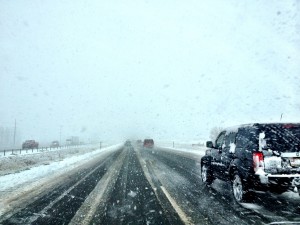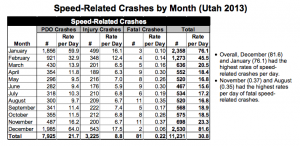
October, November and December bring the highest number of car crashes in Utah.
Gary Mower, research analyst for the Utah Department of Public Safety, calls these last three months of the year “The Three Mishap Months of Fall” in an article he wrote for the Utah Local Technical Assistance Program newsletter.
Mower said in the article that traffic incidents are 29 percent higher in Utah during these months than during the rest of the year. The three-month time period during 2009–2013 had 163.6 crashes per day. The rest of the year, Mower said, averages 134.7 crashes per day.
“December is particularly bad in Utah,” Mower said. “December had the highest crash rate per day every year in the last ten years.”
Helen Knipe, the program coordinator for the Utah Highway Safety Office, is from California, so she didn’t grow up driving in the snow. She said drivers, especially those not used to driving in snow, should learn how to change from a normal driving mindset to a more alert and careful mindset.
“Your dynamics are completely different, even if it’s wet, and especially if there’s snow and ice,” Knipe said. “Even if it doesn’t look like a lot, it’s that mindset. You have to really realize it’s going to be a different experience.”
Mower said drivers’ speeds during the winter are usually lower than in the summer. “Summer usually has higher speeds, which contributes to an increase in the severity of crashes,” he said in an email.
Mower said drivers can avoid crashes by remembering two things. “Driving is a multitask job that demands the full attention of the driver,” he said. “Decrease your speed, and increase your following distance.”

Mower and the director and commissioner for the Utah Department of Public Safety compiled a Utah crash summary for 2013. The summary said speeding is dangerous because it magnifies driving errors, requires for longer distances to safely stop a vehicle and makes it harder for drivers to steer safely around curves in the road.
“Winter weather does not cause crashes,” Mower said. People, however, contribute to the most crashes when they don’t adjust to harsh weather conditions.
Mower said drivers need to do everything slowly, such as accelerating, turning, changing lanes and braking.
Knipe said fast speeds and paying too much attention to crashes lead to chain reactions on highways.
“It’s increased danger for troopers trying to clear the crash, but also to everyone else,” she said. “People are going too fast, brake too hard, they slide out of control and end up hitting the other vehicles that are disabled.”
Wendy Bills, a driver’s education instructor at Provo High School, also said drivers should slow down for snowy conditions and be prepared for accidents by having emergency equipment with them like food, water and blankets.
“(Drivers should) make sure windshields at the front and back and headlights and taillights are cleared off so others can see them,” she said.”Make sure their cars are in good working order for driving.”
This includes having properly inflated tires, considering the option of snow tires and making sure brakes and lights are working.
Drivers should also, if they start to slide, turn the wheel into the skid.
The Utah Highway Patrol posted a video on YouTube last November about driving slowly and safely during the winter. This video by Zero Fatalities and the Utah Highway Patrol shows how to avoid and deal with overcorrections on the road.




